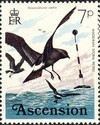Genus Oceanodroma

Band-rumped storm-petrel - The Madeiran Storm-petrel is 19-21 cm in length with a 43-46 cm wingspan, and weighs 44-49g. It is mainly black with an extensive white rump. Similar to Leach's Storm-petrel with the forked tail, long wings, and flight behaviour, but Leach's has a more forked tail and differently shaped white rump.
Fork-tailed Storm Petrel - In North America, it breeds on islands on the Aleutian Islands off Alaska, and on islands along the coasts of British Columbia in Canada and the Pacific Northwest in the United States. The Fork-tailed Storm-petrel also breeds on the Kuril Islands off Kamchatka. This bird breeds in rock crevices or small burrows in soft earth and lays a single white egg. Like most petrels, its walking ability is limited to a short shuffle to the burrow. It is a colonial nester.
Ashy Storm Petrel - This is a small, uniformly sooty-brown storm petrel with a forked tail, closely resembling the Black Storm-petrel, however it is smaller and has a more fluttering style of flight, with the upstroke only becoming horizontal to the body before beginning the downstroke .
Ringed Storm-Petrel - The breeding biology of the Hornby's Storm-petrel is a mystery, as its colonies and nests have never been found. It is thought to breed between March and July, as this is when fledglings are regularly seen at sea around Lima and Antofagasta . There have also been reports of mummified fledglings and adults found in crevices in the Atacama Desert 50 km from the sea, and even reports of one fledgling being seen 150km from the sea, and one unproven report of a bird flying into a nest in the town of Caraz in Peru, 100km from the sea.
Leach's Storm-petrel - It breeds on inaccessible islands in the colder northern areas of the Atlantic and Pacific. It nests in colonies close to the sea in well concealed areas such as rock crevices, shallow burrows or even logs. It lays a single white egg which often has a faint ring of spots at the large end. This storm-petrel is strictly nocturnal at the breeding sites to avoid predation by gulls and skuas, and will even avoid coming to land on clear moonlit nights. The largest colony of Leach's Storm-petrels can be found on Baccalieu Island of eastern Canada, an ecological reserve with more than 3 million pairs of the bird.
Guadalupe Storm-Petrel - The Guadalupe Storm-petrel is a small seabird of the storm-petrel family Hydrobatidae. It is apparently extinct.
Sooty storm-petrel - The Markham's Storm-petrel is a species of seabird in the Hydrobatidae family. It is found in Chile, Colombia, French Polynesia, Peru, possibly Costa Rica, and possibly Ecuador. Its natural habitat is open seas. It is named in honor of Sir Albert Hastings Markham.
Matsudaira's Storm Petrel - It breeds solely in the Volcano Islands in the north-west Pacific Ocean, and winters in the Indian Ocean. Its status is insufficiently known.
Black Storm Petrel - The species breeds colonially on islands off the southern California coast of the United States and off the Baja Peninsula and Gulf of California of Mexico. Nesting sites are usually in rock crevices, occasionally in small burrows in soft earth. It also uses unused burrows from auklets. Colonies are attended nocturnally in order to avoid predatory birds such as gulls, Peregrine Falcons and owls. Like most petrels, its walking ability is limited to a short shuffle to the burrow. The female lays a single white egg per breeding season, if the egg is lost then it is replaced only rarely. Both parents share incubation duties, incubation lasting around 50 days. The chick is brooded for a few days after hatching until it is able to thermoregulate by itself, after which both parents forage to provide food. Chicks fledge 10 weeks after hatching.
Swinhoe's Storm Petrel - Swinhoe's Storm-petrel, Oceanodroma monorhis also known as Swinhoe's Petrel is a small seabird of the storm-petrel family Hydrobatidae.
Sooty storm-petrel - The Tristram's Storm-petrel has long angular wings and is 24 cm long. The plumage is all over dark with a slightly pale rump and a pale grey bar on the upperwing. The species is colonial, nesting in the Northwest Hawaiian Islands, and in several small islands south of Japan, including the Bonin Islands and Izu. Colonies are attended nocturnally, and the species breeds during the winter. At sea the species is pelagic, feeding on squid and fish.



